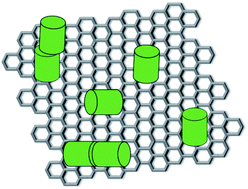Pillararene-functionalised graphene nanomaterials
Abstract
Pillararene-modified graphene materials integrate the advantages of both graphene and pillararenes; e.g., the cavity of pillararenes can recognise suitably sized electron-deficient and hydrophobic guest molecules via host–guest interactions, while the graphene composite is able to exhibit unique physiochemical properties including inertness, nanoscale, electrical and thermal structural properties. Those novel organic–inorganic hybrid composites can be efficiently prepared via both covalent and noncovalent bonds by classic organic reactions and supramolecular interactions, respectively. Pillararene-functionalised graphene materials have been used in various applications, such as electrochemical sensing guest molecules, performing as the platform for fluorescent probes, carrying out fluorescence quenching as the sensor, biosensing toxic molecules in cells, Raman and fluorescence bioimaging of cancer cells, photoacoustic and ultrasound imaging, as well as storage materials and reactors in energy fields.

- This article is part of the themed collection: 2020 Reviews in RSC Advances


 Please wait while we load your content...
Please wait while we load your content...